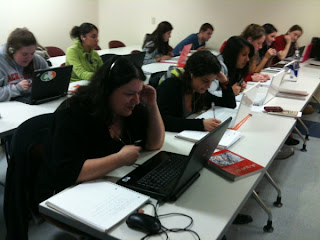Collaborating with World Language Teachers and Classrooms
Thanks to all our dedicated #LangChat Twitter participants who shared some great ideas and suggestions on how we can work with other language teachers and schools on a local, national and global level. We had a lively discussion on Thursday night at 8 p.m. EST, and covered such topics as interacting with other classrooms, collaborating with colleagues around the world, and the role of professional teaching organizations and other personal learning networks (PLNs) in the world language teaching community.
Thanks especially to Sara-Elizabeth Cottrell (@SECottrell) and Erica Fischer (@CalicoTeach) for moderating our chat. You can read the entire archive here.
Exchanging and Interacting with Other Classrooms
Participants had a myriad of ideas for interacting with local, national and global classrooms using a variety of technologies. Skype and Twitter are popular mediums, and teachers shared their successes and problems using these two new technologies in the classroom. While teachers acknowledged it’s often difficult finding reliable contacts for this type of interaction, they generally agreed it’s worth the effort. Below are some of their ideas on how to find classrooms and other groups interested in language and culture exchange, as well as some activities to pursue once you have found a collaborator.
Skype
-
- Two of our collaborating classrooms I found through Twitter. I found the school we befriended in Honduras through our school’s accrediting agency. In addition to Skype, we opened our private blog to the schools, used Glogster and used our class Gmail account. @SECottrell
- Here’s a thought based on how we found the Honduran school: check Council of International Schools http://bit.ly/la4UTW. @SECottrell
- I had two class exchanges and met the other teachers through The Mixxer (http://www.language-exchanges.org/). My best collaboration was with a group of students from Spain. My students talked to them on Skype three times during class. The goal was to practice conversation skills, both English and Spanish. We recorded the conversations and the students corrected each other’s mistakes later. @mundaysa
- Two of our collaborating classrooms I found through Twitter. I found the school we befriended in Honduras through our school’s accrediting agency. In addition to Skype, we opened our private blog to the schools, used Glogster and used our class Gmail account. @SECottrell
-
- Here are my students Skyping with the Spanish kids: http://twitpic.com/59blng. @mundaysa
- It’s great you had individual portals for the students. We were Skyping my whole class with their whole class — a zoo! @SECottrell
- A problem several teachers mentioned with live Skype conversations was that students were often reluctant to communicate voluntarily. Skype chats improved for @lee_bruner after he started using some conversation guides specially developed by @coffeycolleen for facilitating and guiding dual immersion sessions.
- I’ve moderated “quiet conversations” in class via Twitter. @DonaKimberly
- I use visual Visible Tweets at the end of the month as our Twitter “journal.” It’s also effective to collate tweets from breakout groups. @lee_bruner
- I also love the eClickr app for interaction with all types of laptops, smart phones and iOS devices. @lee_bruner
- A couple teachers mentioned using Twitbird to make audio tweets — kids love using this app.
- I set up # strings for my classes and make monthly journals of all the tweets. We follow up with the best tweets to write stories. @dr_dmd
- Many teachers mentioned using #charlando, for Spanish Twitter chats, and #parlons, for French. Another option is being created by @spanish_chat. A problem some teachers noted included students not wishing to participate unless required. Twitter hashtags for students to tweet in the target language are still useful, however, and are worth taking a look at. This summer the hastags may be a little quiet as kids enjoy the outdoors and their time off, but look for them to make a comeback next fall.
Other exchange mediums
- Several teachers mentioned ePals, but evidently it’s hit or miss. Some teachers have found great collaborators through its services, though.
- A few years ago, I had a great collaboration with a school in Bordeaux. We had a blog together and kids updated it weekly. @madamebaker
A few teachers mentioned it’s also a good idea to seek out the local schools and community areas that can allow exchange in the target language.
- My first collaboration was at a local elementary school with bilingual kindergarten. My students shared their children’s stories. I found out about this opportunity through people who knew the community. Then, I made a few phone calls. @MrViscidi
- Cultural demos are a great way to connect students from different backgrounds. We took our ESL classes to several local schools. One of the most successful was a visit to a high school, where we spent time with a high school Japanese class. At one of the schools we visited, the American students showed our girls how to do the Cupid Shuffle (http://twitpic.com/59bjbp). What might seem like a non-educational activity can actually promote a lot of cross-cultural conversation. @MrViscidi
Teacher Resources for Collaboration
There are a TON of resources available for teachers who are interested in collaborating with their peers — whether it be on the local, national or global level. The problem, actually, might be that you can only stay connected with so many personal learning networks (@SECottrell). What do #LangChat participants use to get connected with other teachers and classrooms?
- Many teachers mentioned the FLTeach listserv. However, some teachers believe it can be difficult to navigate, post and read.
- I love interacting with Spanish teachers here: http://teachers.net/mentors/spanish/posts.html. @spanishplans
- A few years back, I set up a link through a local Peace Corps volunteer who went to Senegal. We joined her local high school with my class. Peace Corps now has a formal way to link classes. Go to their website, they have a program and curriculum to check out. @dr_dmd
- French teachers: check for your local Maison du Quebec — or at least the one in LA — tons of stuff! @dr_dmd
- Check out @cybraryman1’s collaboration page: http://tinyurl.com/3azq99t.
- Twitter is of course a great place to meet and collaborate with other language teachers. Apart from our own #LangChat, there are many organizations that have a presence on Twitter. The AATSP Twitter is @AATSPglobal (@SECottrell). A couple teachers mentioned using #edchat.
- Edmodo has a world language community. @dr_dmd
- Wikis are another great way to organize ongoing collaboration. For example, we set up one for the new #APFRENCHPROF collaboration. Check it out: http://t.co/EGfxvXC. @dr_dmd
- For professional development, I have had a great experience with the Language Teachers Collaborate (LTC) wiki. Over 130 active members in 6 months! Check it out: http://tinyurl.com/5w228yg. @DiegoOjeda66
- Skype has launched Skype in the Classroom: http://bit.ly/eNEkXw. @SECottrell
- Spanish teachers, check out: http://profesoresdespanol.ning.com/. @DiegoOjeda66
- I like to use the Yahoo group MoreTPRS and its daily emails. They have a file database, too. @profeguerita
- I invite you to join me on the world language community at Edutopia! We could do lots of collaborative work! @dr_dmd
- Our recent Prezi and handout from a conference presentation on global collaboration between classrooms: http://t.co/JiIFt6N. @engaginged
- For early Language Learning join Nanduti: http://bit.ly/irimMk. @CalicoTeach
- I just caught this resource this week here on #langchat, Connect All Schools: http://bit.ly/geoSM3.
- TES: http://bit.ly/goZRMS requires you to sign up to contribute, but it’s quick and easy. They have a resources sharing facility too. @taskmagic
- Mflresources: http://yhoo.it/7D8tlV is a yahoo email group, similar to FLTeach, but with the ability to attach files, AND posts are not moderated, so you can get a much more fluid discussion going than with FLTeach.. (There are moderators who can delete messages and remove people from the list if they misbehave, however.) Mflresources currently has about 4000 members. A word of caution re mflresources – there can be lots of messages, so you’re best off signing up to it with a web-based email, or even creating a new web-based mail account just for that forum. @taskmagic
Professional Teaching Organizations
Many participants discussed the benefits of joining professional teaching organizations at the local, national or global level. These organizations can offer workshops and conferences, as well as mini-grants for new ideas (@Catherineku1972). Most of @dr_dmd’s best student-to-student collaborations have come from his collaborations with friends and professional colleagues, many of whom he met through professional teaching organizations. Professional organizations are especially great if you can attend annual conferences (@CalicoTeach).
While some teachers said they got a lot of useful information and resources from professional organizations, others mentioned that they didn’t benefit much. Some lamented that professional organizations didn’t address their needs, or weren’t as accessible as they’d like. Most participants agreed that you get what you put into such organizations. One way to start getting involved is to offer what you’ve done by presenting at your state conference (@SECottrell).
So what organizations are #LangChat participants a part of?
- There are four to five of us here with ties to @KWLAonline (Kentucky World Language Association: http://www.kwla-online.org/) — best state teachers’ organization ever! @SECottrell
- Best after WAFLT (Wisconsin Association of Foreign Language Teachers: http://www.waflt.org/)! @DiegoOjeda66
- The American Council on the Teaching of Foreign Languages: http://www.actfl.org/. @dr_dmd
- I recommend you consider joining your specific language’s professional organization, such as AATF for French (American Association of Teachers of French: www.frenchteachers.org/), AATG for German (American Association of Teachers of German: http://www.aatg.org/) and AATSP for Spanish and Portuguese (American Association of Teachers of Spanish and Portuguese: http://www.aatsp.org/). @dr_dmd
- In California, we have CLTA (Californian Language Teachers’ Association: http://www.clta.net/). It has excellent organization, an annual conference, local affiliates and a great network. @dr_dmd
- It isn’t specific to languages, but ASCD is outstanding! (Association for Supervision and Curriculum Development: http://www.ascd.org/) @dr_dmd
- I belong to NYSAFLT (New York State Association of Foreign Language Teachers: http://www.nysaflt.org/) and LILT (Long Island Language Teachers: http://www.liltfl.org/). @profesorM
- Not a professional teaching association, but our school has an Improving Student Learning Committee. Most of my collaboration at school and in the district has evolved from there. @MmeNero
We’ve shared some helpful ideas and resources from our participants this week, I’m sure you can take some inspiration from their thoughts and experiences. Thanks again to everyone who participated, and be sure to check back next week for more great ideas and best practices from your world language colleagues. Don’t forget to keep connecting and collaborating through #langchat, #flteach and the LangChat wiki!






3 Comments
This is great. Thanks for putting it all together and in one place!
You are most welcome!
I am looking for a teacher who would like to skype with my middle school French students.
Merci:)